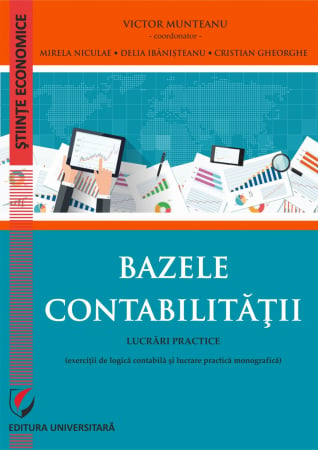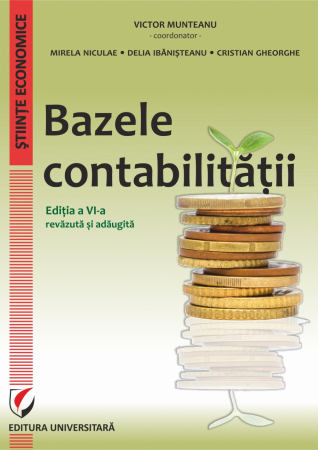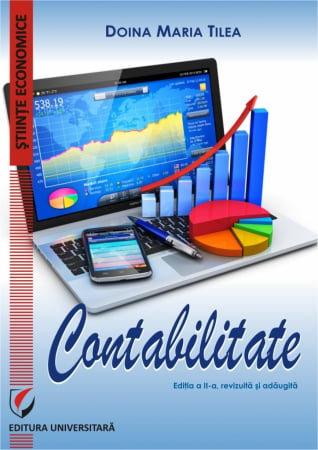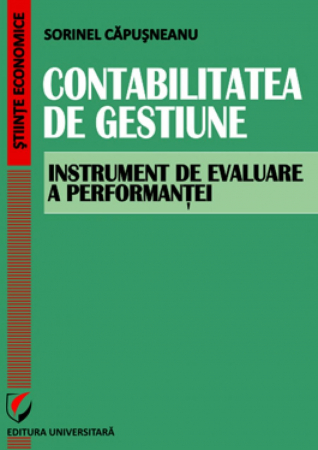Publisher: Editura Universitară
Author: Graziella- Corina Bâtcă-Dumitru, Adriana Florina Popa, Daniela Nicoleta Sahlian, Mihai Vuță, Cleopatra Sendroiu
ISBN: 978-606-28-1257-7
DOI: https://doi.org/10.5682/9786062812577
Publisher year: 2021
Edition: I
Pages: 288
- Description
- Download (1)
- Authors
- Content
- More details
- Reviews (0)
Mainly, the book addresses specific aspects of accounting in Romania, but placed in an international context. In this sense, obtaining and using information necessary for managerial decisions is, for example, an "international language". In addition, the analysis of a business's performance is presented in a dual way, both from a continental (French) and an Anglo-Saxon perspective. Last but not least, the reader has the opportunity to assume the “risk” of trying to understand the role of financial instruments, both from a financial and accounting perspective, in order to be able to use, later, the respective information in the existing risk management process. within a business.
-
Accounting. Business tool for managers
Download
ADRIANA FLORINA POPA
DANIELA NICOLETA SAHLIAN
CLEOPATRA SENDROIU
MIHAI VUTA
CHAPTER I
ACCOUNTING INFORMATION - BUSINESS FINANCIAL REPRESENTATION SUPPORT / 11
1.1. ACCOUNTING PRINCIPLES / 12
1.1.1. The principle of independence of the exercise / 12
1.1.2. The principle of the faithful image / 12
11.3. The monetary principle (of the monetary unit) / 13
1.1.4. The principle of intangibility / 13
1.1.5. The principle of significant importance / 13
1.1.6. The principle of the time period / 14
1.1.7. The principle of accrual accounting / 14
1.1.8. The principle of historical cost / 14
1.1.9. The principle of prudence / 15
1.1.10. The principle of permanence of methods / 16
1.1.11. The principle of continuity of activity / 16
1.2. CHARACTERISTICS OF ACCOUNTING INFORMATION / 18
1.2.1. Intelligibility / 19
1.2.2. Relevant (pertinent) / 20
1.2.3. Reliability / 21
1.2.4. Comparability / 22
1.3. USERS OF ACCOUNTING INFORMATION / 23
1.3.1. What is the value? / 24
1.3.2. Characteristics of users of accounting information / 27
1.3.3. Performance - important factor in decision making by users of accounting information / 31
CHAPTER II
ACCOUNTING INSTRUMENTATION OF MAIN CURRENT REVENUE OPERATIONS AT BUSINESS LEVEL / 37
2.1. GENERAL ASPECTS / 37
2.2. OPERATING REVENUE / 38
2.2.1. Revenues from the sale of products and goods, as well as services / 40
2.2.1.1. Income from sales of goods / 40
2.2.1.2. Revenue from the provision of services / 50
2.2.2. Revenues related to the cost of production / 52
2.2.3. Income from the production of fixed assets / 54
2.2.4.Income from investment subsidies / 55
2.2.5.Other operating income / 57
2.3. FINANCIAL REVENUE / 64
2.4. REVENUE FROM ADJUSTMENTS AND PROVISIONS / 72
CHAPTER III
MANAGEMENT ACCOUNTING SOURCE OF INFORMATION FOR THE DECISION-MAKING PROCESS / 76
3.1. INTRODUCTION TO MANAGEMENT ACCOUNTING / 76
3.1.1. Definition and scope of managerial accounting / 76
3.1.2. The functions of managerial accounting / 79
3.1.3. Scope of applicability of managerial accounting / 80
3.1.4. Costs / 81
3.1.5. Cost behavior / 82
3.1.6. Relevant range / 84
3.1.7. Mixed costs / 85
3.1.8. Cost to profit volume analysis (CVP) / 86
3.1.9. Cost structure and operational leverage / 92
3.1.10. Product cost and cost allocation / 96
3.1.11. Allocation of indirect costs / 101
3.1.12. Alternative methods of stock valuation / 110
3.1.13. Absorption - based calculation methods / 111
3.1.14. Variable cost method (marginal cost method) / 111
3.1.15. Comparison of absorption - based costs with variable costs / 112
3.1.16. Througput accounting / 116
3.2. MANAGEMENT ACCOUNTING AND OPERATIONAL DECISIONS / 116
3.2.1. Management of production operations / 118
3.2.2. Operational management in service organizations / 121
3.2.3. Cost of unused / spare capacity / 122
3.2.4. Capacity utilization and product mix / 123
3.2.5. Operational decisions: relevant costs / 126
3.2.6. Produce or buy? / 127
3.2.7. Decisions to accept special orders / 130
3.2.8. Equipment replacement / 133
3.2.9. The cost of losing a customer / 134
3.2.10. Investment evaluation techniques / 135
CHAPTER IV
BUSINESS ACCOUNTING INFORMATION SYSTEM - ANALYSIS BASED ON FINANCIAL STATEMENTS / 145
4.1. ANALYSIS BASED ON THE BALANCE SHEET / 145
4.1.1. Balance sheet asset structure indicators / 147
4.1.2. Structural indicators of financing sources / 152
4.1.3. Liquidity indicators / 153
4.1.4. Solvency indicators / 154
4.1.5. Rotation speed indicators / 156
4.2. ANALYSIS BASED ON THE PROFIT AND LOSS ACCOUNT / 160
4.2.1. Interim management balances - French approach / 161
4.2.2. Accumulation margins - Anglo-Saxon approach / 164
4.3. CASH FLOW STATEMENT ANALYSIS - CASH FLOW AVAILABLE - MOST RELEVANT INDICATOR FOR MEASURING FUTURE GAINS / 166
4.4. INDICATORS REGARDING THE PROFITABILITY OF THE ENTERPRISE / 169
4.5. PROFITABILITY, SECURITY AND PROFITABILITY THRESHOLD AS A BUSINESS TOOL / 173
4.6. PROFITABILITY THRESHOLD AND BUSINESS ACCOUNTING / 177
4.7. RISK OF BANKRUPTCY / 184
4.8. DESCRIPTION OF FINANCIAL PERFORMANCE BY PRISM OF EARNINGS PER SHARE / 185
4.9. MARKET POSITION INDICATORS / 190
CHAPTER V
FINANCIAL INSTRUMENTS - USEFUL ALTERNATIVES FOR BUSINESS RISK MANAGEMENT / 194
5.1. INTRODUCTION / 194
5.2. PRIMARY FINANCIAL INSTRUMENTS / 195
5.3. SHARES VERSUS BONDS AS SECURITIES ISSUED BY JOINT STOCK COMPANIES / 195
5.3.1. Characteristics of actions. Attached values / 196
5.3.2. Accounting and fiscal treatments related to share transactions. Issuer versus investors / 200
5.3.2.1. Establishment of the share capital in the case of joint stock companies / 202
5.3.2.2. Increasing the share capital through new contributions; calculation and interpretation of ds / 210
5.3.2.3. Redemption of own shares; resale / cancellation of repurchased shares / 215
5.3.2.4. Accounting and fiscal aspects regarding the redemption and resale of own shares / 217
5.3.2.5. Accounting and fiscal aspects regarding the redemption and cancellation of own shares / 221
5.3.2.6. Accounting and taxation of acquisitions, sales and inventory valuation of shares / 223
5.3.2.7. Accounting and taxation of participation in kind in the establishment of the capital of another company. subsequent receipt of securities (shares) without payment / 233
5.3.3. Bond characteristics. attached values / 238
5.3.4. Accounting treatments regarding bonds and loans from bond issues. Issuer versus investors / 240
5.4. DERIVATIVE FINANCIAL INSTRUMENTS / 249
5.4.1. Generalities / 249
5.4.2. The forward contract / 251
5.4.3. The futures contract / 261
5.4.4. Contract options / 268
5.4.4.1. The mechanism of buying / selling a call option / 269
5.4.4.2. The mechanism of buying / selling a call option / 271
5.4.5. Swap contracts / 280
BIBLIOGRAPHY / 285
Mainly, the book addresses specific aspects of accounting in Romania, but placed in an international context. In this sense, obtaining and using information necessary for managerial decisions is, for example, an "international language". In addition, the analysis of a business's performance is presented in a dual way, both from a continental (French) and an Anglo-Saxon perspective. Last but not least, the reader has the opportunity to assume the “risk” of trying to understand the role of financial instruments, both from a financial and accounting perspective, in order to be able to use, later, the respective information in the existing risk management process. within a business.
The journey in the world of accounting ideas begins gradually, through a presentation of some principles, existing over time, both explicitly (in accounting legislation) and implicitly (in various senses). These have the role of familiarizing the reader with the professional reasoning used in order to offer accounting information. Subsequently, the professional accountant is challenged by presenting specific accounting cases. In their rendering, the accounting treatment is combined with the fiscal treatment, respectively the implications on the financial reporting are presented.
The constantly changing economic context leads to questions such as: What is the amount that should be manufactured from a particular product to make a profit? What is the mix of products that allow maximizing performance in conditions of limiting factors? Is it better to produce or buy a certain component? The processing of accounting information represents the starting point in determining some indicators and performing useful analyzes of the managerial decisions involved in these situations.
Is it good to invest in a business? Does the company have sufficient resources to repay a bank loan or to pay its suppliers? Can I count on the existence of the same supplier in the future? These are other types of questions that an investor, a financial or commercial creditor, or a client can ask themselves. The answer to such questions can be found after understanding the information provided by the financial statements and the indicators calculated based on them.
Economic crises have the role of activating latent risk management mechanisms. Understanding contracts such as financial derivatives is an important asset for entrepreneurs / managers and a competitive advantage for professional accountants who may face real challenges in recognizing such transactions in accounting.
Going through the work Accounting - a business tool for managers is a professional challenge for all those interested in the evolution of a business. The synergy effect created by the presentation of intercorrelated information from several "sections" is an important asset for improving the supply of information by professional accountants, respectively increasing their understanding by entrepreneurs / managers. Last but not least, students have the advantage of capturing an overview, able to help them understand the complexity of accounting and related information in order to choose a "section" in which they want to operate in the future in the economic perimeter.
Prof. univ. Dr. Daniela Artemisa Calu

6359.png)
![Accounting. Business tool for managers [1] Accounting. Business tool for managers [1]](https://gomagcdn.ro/domains/editurauniversitara.ro/files/product/large/contabilitate-instr-de-business-pt-manageri_bt-3127-9152.jpg)














